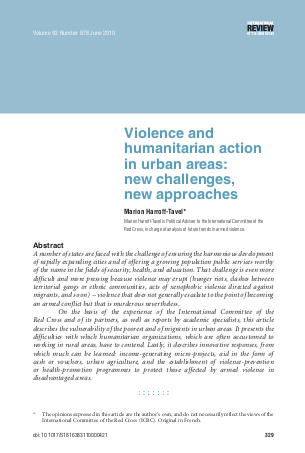International annual review

A number of states are faced with the challenge of ensuring the harmonious development of rapidly expanding cities and of offering a growing population public services worthy of the name in the fields of security, health, and education. That challenge is even more difficult and more pressing because violence may erupt (hunger riots, clashes between territorial gangs or ethnic communities, acts of xenophobic violence directed against migrants, and so on) – violence that does not generally escalate to the point of becoming an armed conflict but that is murderous nevertheless. On the basis of the experience of the International Committee of the Red Cross and of its partners, as well as reports by academic specialists, this article describes the vulnerability of the poorest and of migrants in urban areas. It presents the difficulties with which humanitarian organizations, which are often accustomed to working in rural areas, have to contend. Lastly, it describes innovative responses, from which much can be learned: income-generating micro-projects, aid in the form of cash or vouchers, urban agriculture, and the establishment of violence-prevention or health-promotion programmes to protect those affected by armed violence in disadvantaged areas.
Links
Resource collections
- UN Habitat - Urban Response Collection
- Urban Response - Urban Crisis Preparedness and Risk Reduction
- Urban Response Collection - Community Engagement and Social Cohesion
- Urban Response Collection - Economic Recovery
- Urban Response Collection - Environment and Climate Change
- Urban Response Collection - Housing, Land and Property
- Urban Response Collection - Urban Crisis Response, Recovery and Reconstruction
- Urban Response Collection - Urban Resilience